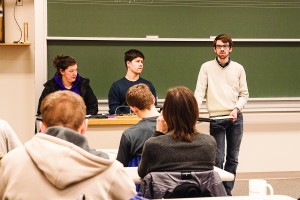The senators troop into the weekly SGA meeting in small groups at a time, chattering and taking their time to find their seats. It’s 10 in the evening but, besides a few yawns here and there, the group doesn’t appear to be tired. Soon the meeting begins with role, read by Andiana Siddell, vice-president of the body. Each senator responds with a “present” to their name as the conversation dies to a low murmur.
 This body looks different than it did a year ago, and that’s all due to new changes in the SGA’s constitution. Last year, sensing that an inadequate number of constituencies were being represented, SGA adjusted its constitution in regards to its representation. Now, instead of only requiring a member to be a representative of a class and no more, the constitution stipulates that “Active Membership of the Senate shall be composed of three members elected by each class, one member elected by each on-campus student residence, one member elected by the varsity athletes, and one member elected by each academic area.” The main goal, after all, is to get more groups on campus represented.
This body looks different than it did a year ago, and that’s all due to new changes in the SGA’s constitution. Last year, sensing that an inadequate number of constituencies were being represented, SGA adjusted its constitution in regards to its representation. Now, instead of only requiring a member to be a representative of a class and no more, the constitution stipulates that “Active Membership of the Senate shall be composed of three members elected by each class, one member elected by each on-campus student residence, one member elected by the varsity athletes, and one member elected by each academic area.” The main goal, after all, is to get more groups on campus represented.
The result of the changes? According to Hardy, “It’s a mixed bag right now. I think it’s given us a Senate that has a little more diversity than it has had in the past, but at the same time it’s harder to fill all of those seats.” Indeed, getting people to fill the empty seats has been a task that SGA has been undertaking all year but, for some reason or another, students have been less than keen to take on the positions.
Hardy attributes these difficulties to both low enrollment and overworked students, but he also mentions something else. Students, he says, remain largely ignorant of what SGA does, though, he adds sarcastically, “Apparently, people know that we do Donut Day.” Jokes aside, Hardy fears “about what is it that we’re actually doing that gives value to students.” Said Hardy, “I think more than changing the structure, this is leading to a new conversation about what student government should actually be doing.”
The question of student government’s relevancy is a significant one for other reasons, particularly just as Houghton is expanding into nontraditional educational areas such as online education programs through its partnership with Indiana Wesleyan University and two-year degree programs to begin next year in Buffalo. The inclusion of these programs should introduce a new population of students, ones not located on campus, and with it becomes a problem of representing these students in student government.
Partly because of these new changes, according to Greg Bish, director of student programs, “What students need today is not what was needed in the past.” Bish has been encouraging the current cabinet to examine “progressive models” of student government on other campuses to begin modernizing student government at Houghton. A key question to ask, said Bish, in the coming weeks and months to come is “As we consider the number of residential students in addition to online, graduate, and two-year degree students, with the addition of the social media and technology of today, what is the appropriate amount of student leadership?”
Hardy echoed Bish’s sentiments and added that, since the current model was formed “in the late 80s or in the 90s”, it’s about time for an update. For now, though, with the election cycle for the next senate and cabinet well underway, it appears as if an update is still a long ways away
